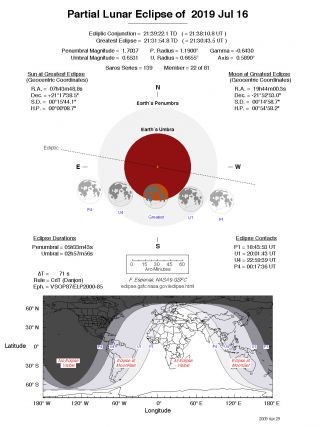See the ‘Half Blood’ Lunar Eclipse of 2019 Live Today with Slooh – Space.com
The moon will dip through part of the Earth’s shadow today in a partial lunar eclipse today (July 16) and you can watch it live online, courtesy of the astronomy broadcast service Slooh.
Today’s eclipse, the last lunar eclipse of 2019, will be visible primarily from South America, Europe, Asia, Africa and Australia, and Slooh will offer live views of the mission from 2:40 p.m. to 8:20 p.m. EDT (1840 to 0020 GMT), from its remotely operated telescopes. You can tune in to the webcast at Slooh’s website here, with the website dubbing the event a “Half Blood Lunar Eclipse.”
You will also be able to watch the webcast live at Space.com here, courtesy of Slooh. Slooh uses remotely operated telescopes around the world to connect members to the night sky. Tonight’s webcast is available to the public, with memberships for regular access starting at $20 per year.
Related: Amazing Photos of the Super Blood Wolf Moon of 2019!

This map shows the region of visibility for the partial lunar eclipse of July 16, 2019. Observers in South America, Europe, Africa, Asia and Australia will be able to see the eclipse, weather permitting.
(Image credit: NASA/Fred Espenak)
Lunar eclipses happen when the full moon passes through Earth’s shadow as it orbits on the opposite of the planet from the sun. When the moon is completely in the Earth’s shadow, a total lunar eclipse occurs. The deepest part of the shadow is called the umbra. In today’s eclipse, the moon is passing only partly into the umbra, so this will be a partial lunar eclipse.
Full lunar eclipses turn the moon a shade of red because the only light that reaches the moon’s surface is from the refracted sunrises and sunsets around planet Earth. The color changes of partial eclipses are difficult to predict, but astronomers hope this one will turn the moon red, Slooh said in a statement.
“Although this isn’t a total lunar eclipse, we will still see the magical change of color as 65% of the full buck moon enters Earth’s umbral shadow,” Paul Cox, Slooh’s chief astronomical officer, said in a statement. “It’s difficult to predict the color of an eclipsed moon because the condition of Earth’s atmosphere affects it — but with recent volcanic activity spewing dust into the atmosphere, we’re hoping for a ‘half blood moon.'”
Unlike solar eclipses, lunar eclipses are perfectly safe to view with your naked eye or with binoculars or a telescope. Lunar eclipses are visible anywhere the moon is visible in the sky; Slooh will be offering coverage from observatory locations in Australia, Asia, Europe and Africa. (This lunar eclipse won’t be visible over North America.)
Besides the live feed, Slooh will also host a discussion about eclipse science hosted by Paige Godfrey, Slooh astrophysicist, between 4 p.m. and 7 p.m. EDT (2000 to 2300 GMT). Viewers can ask questions during the show on Twitter using the hashtag #Slooh.
In Italy, astrophysicist Gianluca Masi of the Virtual Telescope project will also host a live lunar eclipse webcast. Tht feed will begin at 4:30 p.m. EDT (2030 GMT) and show live views of the moon from Rome. You can watch that lunar eclipse feed via the Virtual Telescope website here.
“Seeing the Moon sinking in the Earth’s shadow is always very fascinating, even
when the eclipse is just partial,” Masi told Space.com via email. “People are always attracted by these natural shows, but this year the eclipse will have a special ‘flavour’: it will happen on the same day of the Apollo 11 liftoff, 16 July 1969, so 50 years later. A great way to celebrate.”
Follow Elizabeth Howell on Twitter @howellspace. Follow us on Twitter @Spacedotcom and on Facebook.






